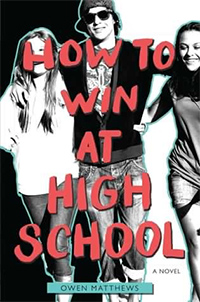| ________________
CM . . . . Volume XXI Number 28 . . . . March 27, 2015
excerpt:
Adam Higgs is not popular. He is, in fact, a loser (his words). He may as well be invisible as far as the "gods" (read: popular kids) of Nixon Collegiate are concerned. Prior to being paralysed in an ill-fated high school hockey game, Adam's older brother, Sam, was not a loser. He was, in fact, a god (Adam's words, again). It is Sam's esteem of his younger brother, more than anything else, that drives Adam to extreme lengths- any lengths necessary- to shed his loser status during his junior year at Nixon Collegiate. Adam begins his quest to shed his loser image somewhat inadvertently with his decision to complete a lab project for the most popular girl in the junior class. "Sarah (expletive) Bryant" (the moniker by which Adam refers to Sarah, throughout the novel) leads the social ruling class at Nixon. The demand for Adam's fraudulent homework services quickly exceeds the limits of his time and energy and begins to threaten his fledgling relationship with the beautiful and popular (albeit chaste and ambitious), Victoria. Nevertheless, Adam forges ahead, taking on a team of equally unpopular and reasonably intelligent underlings to whom he delegates much of his workload while Adam, himself, taps into a new market as Nixon's resident bootlegger and (eventually) drug dealer. Constantly upping the ante in his desire to solidify his newfound status as a "god" (popular kid), Adam finds himself in increasingly more dangerous situations- with less and less time to spend with his girlfriend and disabled brother. Before long, his straightlaced girlfriend walks out of his life and his brother begins to distance himself. Adam's roster of employees dwindles as his demands, and the risks he is willing to take, continue to mount. His stock with the Nixon "gods", however, skyrockets as he racks up sexual conquests and gains a reputation as the primary supplier of drugs and alcohol at parties. As quick as his meteoric rise to high school infamy begins, it all comes crashing down. After letting an uninvolved student take the fall for a school break-in and theft of a final exam, and coming face-to-face with a legitimate drug dealer (the former supplier of the Nixon "gods"), Adam finds himself physically and mentally beaten, expelled from Nixon, and facing the prospect of spending the remainder of his high school years at a school for juvenile delinquents. He accepts his lot and finds himself surprisingly relieved to be free of the pressure of maintaining "god" status at Nixon. How to Win at High School ends on a high note, with Adam's former girlfriend forgiving him the error of his ways and the school district giving him a second chance at a new, less prestigious school, where he is grateful to simply fit in. Owen Matthews' novel is written in such a way as to make it appealing to both reluctant and advanced readers. He covers a wide range of challenging subject matter, using simple language, peppered with just enough expletives and off-colour jokes to engage even those teens less inclined to see a novel through to its conclusion. The language, sexual and drug-related content may be off-putting to parents or educators of younger teens; however, Matthews' book would be an excellent starting point for encouraging reluctant older readers to progress beyond the similar, yet considerably shorter, easy-read series aimed at teens. Recommended. Amy Trepanier is the Teen Services Manager at Red Deer Public Library in Red Deer, AB. Copyright © the Manitoba Library Association. Reproduction for personal use is permitted only if this copyright notice is maintained. Any other reproduction is prohibited without permission.
Next Review |
Table of Contents for This Issue
- March 27, 2015. |
